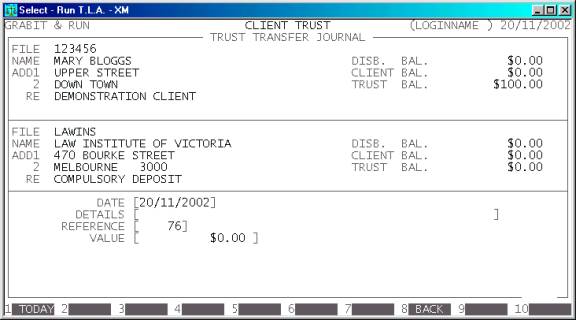Total
Legal Accounting 3
SECTION
1.3.1.3 - TRUST TRANSFER JOURNALS
USAGE: To transfer amounts from one Trust file to
another. There are many instances where monies, initially posted to one file must
be transferred in whole or part, to another file. These transfers might not
involve actual transfers of money by Cheque, etc.
DISCUSSION:
When you start the TRUST TRANSFER program,
T.L.A. initially asks you for a Trust file number. This is the to-Debit
account. Money will be transferred out of this file’s Trust Balance. If you
cannot remember the file number, press <F9> to initiate a search.
T.L.A. will check that the code does not refer to a Trust file that is closed.
Next you will be asked to enter the code of the
to-Credit account. Moneys will be transferred into this file’s Trust Balance.
Again, if you cannot remember the file number, press <F9> to initiate a search.
T.L.A. will check that the code also does not refer to a Trust file that is closed.
Typically, the screen will now look like this:

Each of the two files will be displayed with their
corresponding Name, Address and Matter Re. Also the current Disbursement,
Client and Trust balances are displayed on the left of the screen. These
balances are updated when monies are applied to show you what the account will
be when the current transaction is updated. This can be a useful check. You
should look at these balances before updating the line.
You cannot send either file into a negative Trust
balance unless the code is LAWINS (which is a special file
set aside for Law Institute Deposits).
Next you must enter the details of the transaction.
There are several fields to enter:
Name Comments
DATE This field
defaults to today’s date (as per the date at the top right-hand-corner of your
screen. You may change it to any valid date within the calendar (as defined in SECTION 7.1.6.) You may also return the date to today’s
date by pressing <F1>. Note that this date has an effect on clearance dates. You should
enter the date you actually moved the money.
DETAILS Here you enter the details of the transaction, eg. PARTIAL TRANSFER.
REFERENCE This field will default to the
last reference number you entered, plus one. Depending on your settings in SYSTEM
DEFAULTS (see SECTION 7.1.2) you may be able
to change it to a different, non-zero value. The largest value available is 999999.
VALUE This is the value of the transfer. This amount can be
negative if you are reversing a previously incorrect entry.
At each point, you may cancel the TRANSFER
JOURNAL by pressing <ESC>. However, it is possible to
return to a specific field by using <CsrUp> or <F8>.
At the end of the TRANSFER JOURNAL you will be asked to confirm the update. This is
the point of no return. Once you answer Y, T.L.A. will update all the relevant files.
Up to this point you can cancel or modify the details. After you have updated
the TRANSFER JOURNAL, you can only
remove it by entering a negative TRANSFER
JOURNAL i.e. the same entry but
with a negative value.
Files updated by the Trust Transfer Journal program:
Client/Trust
master-file: The amount will be
deducted from the Trust balance of the first file and added to the Trust
balance of the second file. Also the last Trust transaction date is updated.
Client/Trust
transaction file: Each transfer generates
a transaction. This can be viewed in CLIENT/TRUST
ENQUIRIES and is used to create reports, such as CLIENT STATEMENTS.
Audit
transaction-file: Each
transaction creates a line in the Audit file, which can then be printed in the AUDIT
TRAIL.